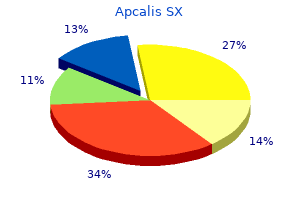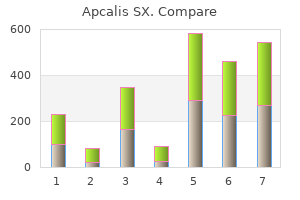Apcalis SX
"Discount apcalis sx uk, erectile dysfunction pill brands".
By: U. Khabir, M.S., Ph.D.
Associate Professor, Alabama College of Osteopathic Medicine
Conclusion: Variegated corn kernels result from the excision of Ds parts from genes controlling pigment manufacturing during development erectile dysfunction 14 year old purchase apcalis sx paypal. Each P element possesses terminal inverted repeats and generates flanking direct repeats on the site of insertion erectile dysfunction in young buy 20 mg apcalis sx free shipping. The position of this repressor in controlling transposition is demonstrated dramatically in hybrid dysgenesis erectile dysfunction doctor in chennai cheap apcalis sx line, which is the sudden look of numerous mutations, chromosome aberrations, and sterility within the offspring of a cross between a P+ male fly (with P parts) and a P- female fly (with out them). In a cell that contains P parts, a repressor within the cytoplasm inhibits transposition. When a P+ female produces eggs, the repressor protein is included into the egg cytoplasm, which prevents further transposition within the embryo and thus prevents mutations from arising. When eggs from a P- female are fertilized by sperm from a P+ male, the absence of repression allows the P parts contributed by the sperm to endure fast transposition within the embryo, inflicting hybrid dysgenesis (Figure 11. A comparability of human and chimpanzee genomes suggests Chromosome Structure and Transposable Elements 313 (a) No hybrid dysgenesis P generation P� (1 Cross a P � male and a P + female. P� & & Gamete manufacturing Repressors P element Paternal chromosomes with out P parts 2 A repressor within the egg cytoplasm inhibits the transposition of P parts. Zygote Zygote three Thus, P parts on the paternal chromosomes endure a burst of transposition-hybrid dysgenesis-. Every human cell contains more than 1 million related, but not equivalent, copies of Alu in its chromosomes. Alu belongs to a class of repetitive sequences found frequently in mammalian and another genomes. Examples of transposable parts in this class embody insertion sequences and all complex transposons in micro organism, Ac and Ds parts in maize, and P parts in Drosophila. Much of the super variation in genome size found amongst eukaryotic organisms is because of variations in numbers of transposable parts. Approximately forty five% of the human genome consists of remnants of transposable parts and about 50% of all spontaneous mutations in Drosophila are as a result of transposition. Homologous recombination between copies of transposable parts has been an essential force in producing gene duplications and different chromosome rearrangements. Transposable parts can be divided into two main lessons on the idea of structure and movement. Examples of retrotransposons embody Ty parts in yeast and Alu sequences in humans. The Evolution of Transposable Elements Transposable parts exist in all organisms, typically in giant numbers. The insertion of transposable parts into a gene will typically destroy its function, with dangerous consequences for the cell. Furthermore, the time and energy required to replicate giant numbers of transposable parts are more likely to place a metabolic burden on the cell. Thus, transposable parts can be thought of as genomic parasites that present no profit to the cell and should even be dangerous. Their capacity to reproduce and unfold is what makes them frequent, not their necessity to the cell. Transposable parts and genetic variation the process of evolution requires the presence of genetic variation inside a inhabitants (see Chapter 26). Because transposable parts induce mutations and chromosome rearrangements, some scientists have argued that they exist as a result of they generate genetic variation, which facilitates evolutionary adaptation. This thought means that a specific amount of genetic variation is useful as a result of it allows a species to adapt to environmental change. However, much of what we learn about transposable parts and evolution works in opposition to this speculation. Some mutations brought on by transposable parts may permit species to evolve useful traits, but most mutations generated by random transposition have deleterious instant results and will probably be eradicated by natural selection. Another cellular function that may have originated as the results of a transposable element is the process that maintains the ends of chromosomes in eukaryotic organisms. In germ cells and single-celled eukaryotic organisms, chromosome length is maintained by the enzyme telomerase. The mechanism utilized by telomerase is much like the reverse-transcription process utilized in retrotransposition, and telomerase is evolutionarily related to the reverse transcriptases encoded by certain retrotransposons. These findings counsel that an invading retrotransposon in an ancestral eukaryotic cell may have provided the ability to copy the ends of chromosomes and ultimately developed into the gene that encodes the modern telomerase enzyme. Drosophila lacks the telomerase enzyme; retrotransposons seem to have resumed the position of telomere upkeep in this case.

Students learn to erectile dysfunction treatment new orleans buy discount apcalis sx 20mg on line visually perceive nonlinear relationships between information insulin pump erectile dysfunction buy apcalis sx 20 mg otc, in contrast to erectile dysfunction and diabetes type 2 apcalis sx 20 mg on-line cross-referencing within linear text. Each amino acid also accommodates one of 20 distinctive aspect chains hooked up to the -carbon atom. The chemical nature of this R group determines the function of an amino acid in a protein and offers the idea for classification of the amino acids as nonpolar, uncharged polar, acidic (polar adverse), or primary (polar optimistic). All free amino acids, plus charged amino acids in peptide chains, can serve as buffers. The -carbon of every amino acid (except glycine) is hooked up to four completely different chemical teams and is, therefore, a chiral, or optically lively carbon atom. C represents the isoelectric point, or pI, and as such is halfway between pK1 and pK2 for a nonpolar amino acid. The peptide would move to the cathode (adverse electrode) throughout electrophoresis at pH 5. The two cysteine residues can, underneath oxidizing circumstances, type a disulfide (covalent) bond. The net cost on the peptide at pH 5 is adverse, and it will move to the anode. Given that the pKa of aspirin (salicylic acid) is three, calculate the ratio of its ionized to un-ionized forms at pH 7. The linear sequence of the linked amino acids accommodates the information necessary to generate a protein molecule with a novel three-dimensional shape. The complexity of protein structure is finest analyzed by considering the molecule by way of four organizational levels: major, secondary, tertiary, and quaternary (Figure 2. An examination of those hierarchies of increasing complexity has revealed that sure structural components are repeated in a wide variety of proteins, suggesting that there are basic "rules" relating to the ways during which proteins achieve their native, practical type. These repeated structural components range from easy mixtures of -helices and sheets forming small motifs, to the complicated folding of polypeptide domains of multifunctional proteins (see p. Understanding the first structure of proteins is important as a result of many genetic illnesses end in proteins with abnormal amino acid sequences, which cause improper folding and loss or impairment of normal function. If the first structures of the traditional and the mutated proteins are recognized, this information could also be used to diagnose or examine the disease. Peptide bond In proteins, amino acids are joined covalently by peptide bonds, that are amide linkages between the -carboxyl group of 1 amino acid and the -amino group of one other. For example, valine and alanine can type the dipeptide valylalanine by way of the formation of a peptide bond (Figure 2. Peptide bonds are resistant to circumstances that denature proteins, corresponding to heating and high concentrations of urea (see p. Prolonged exposure to a powerful acid or base at elevated temperatures is required to break these bonds nonenzymically. Naming the peptide: By convention, the free amino finish (N-terminal) of the peptide chain is written to the left and the free carboxyl finish (C-terminal) to the right. Therefore, all amino acid sequences are read from the N- to the C-terminal finish of the peptide. When a polypeptide is known as, all amino acid residues have their suffixes (-ine, -an, -ic, or -ate) changed to -yl, excluding the C-terminal amino acid. For example, a tripeptide composed of an N-terminal valine, a glycine, and a C-terminal leucine is known as valylglycylleucine. This prevents free rotation around the bond between the carbonyl carbon and the nitrogen of the peptide bond. Thus, the charged teams present in polypeptides consist solely of the N-terminal (-amino) group, the C-terminal (-carboxyl) group, and any ionized teams present in the aspect chains of the constituent amino acids. Determination of the amino acid composition of a polypeptide step one in figuring out the first structure of a polypeptide is to identify and quantitate its constituent amino acids. A purified pattern of the polypeptide to be analyzed is first hydrolyzed by robust acid at one hundred ten�C for twenty-four hours.
Cheap 20mg apcalis sx fast delivery. Ron Paul at Maine caucus kidney disease in Central America (In Context Liberty News).

Syndromes
- The risk of passing the infection to the baby is highest if the mom first becomes infected with genital herpes during pregnancy. The risk for severe infection in the baby is much lower in recurrent outbreaks.
- Infections (abscesses)
- Severe abdominal pain
- Birth defects that involve the spine or brain, such as spina bifida
- Breathing problems
- X-rays
- Pernicious anemia
- Life-threatening blood infection (sepsis). The risk is greater among the young, very old adults, and those whose bodies cannot fight infections (for example, due to HIV or cancer chemotherapy)
- Fluid drainage from a pit on the neck
- The doctor inserts a needle into your skin. Then the nephrostomy catheter is passed through the needle into your kidney.
